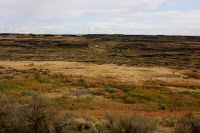Soooo. I have returned! And basically the time since I returned yesterday and getting time to sit down and write this has been filled with business and sleeping. Margaret and I were in the lounge doing homework (actually, she was doing homework and I was messing around) and I decided to take a nap (at 8:30). When she decided to leave, I headed to bed (at 10:00). I sat up in my bed with my computer and did my one reading for one class in the morning (at 7:00). I was ridiculously tired after nearly FREEZING to death the night before and getting little to no sleep in my tent and sleeping bag.
I am going to tell the tale of my field-trip in installments because it would be quite difficult to sit down and recite the whole thing all at once.
First, I want to say that Washington is absolutely gorgeous this time of year. There is this perfect mix of dark green coniferous trees, medium green leaves on deciduous trees that haven't started to change, lime green leaves on trees just starting to change, bright banana yellow leaves, fiery yellowy orange leaves, flaming red-orange leaves, and an exact sprinkling of crimson that gives an extra autumn-y burst to the forest. I didn't get any pictures because we were driving quickly over the pass, but it was drizzly and it was amazingly pretty.
We left the school around 8:30AM (which means I was up at 7:00AM) in two big 12-seater vans and a cargo van. The whole van was passed out pretty much the whole way to our first stop which was Drumroll Please!!!
Drumheller Channels




This was the first southern-most stop in our journey. It is right near the Saddle Mountains, and this is where the floodwaters picked up speed again as the terrain got more narrow. We can determine that this was created by a raging flood and not by the river meandering because not only are all the rocks angular, but everything is covered in what is called "scab-lands." This is when all of the "loess" or soil that creates the rolling farmlands is washed away and all that is left is a little bit of topsoil on top of rock.
The raging water smashed through the area and created unique geological features such as this:

I also took this pictures just for you Dad! It's a fowl... perhaps even a water fowl!

I also saw this picture and couldn't NOT take it.

We then went on to Lind Coulee a little farther North. In my little discussion group, I said that it was created by slow moving or still water and the other girls in my group were like "NO! blah blah blah it was made by wind blah blah blah you're wrong blah blah blah." When we got into the big group, we found out that the deposits of clay (the finest of the mineral types (finer than sand and silt)) were created by *gasp* slow moving or still water. This is where the flood widened out, slowed down, barely moved. Before getting more narrow at Drumheller.
Alright. Now I'm off to crew. I'll add the next bit later!
No comments:
Post a Comment